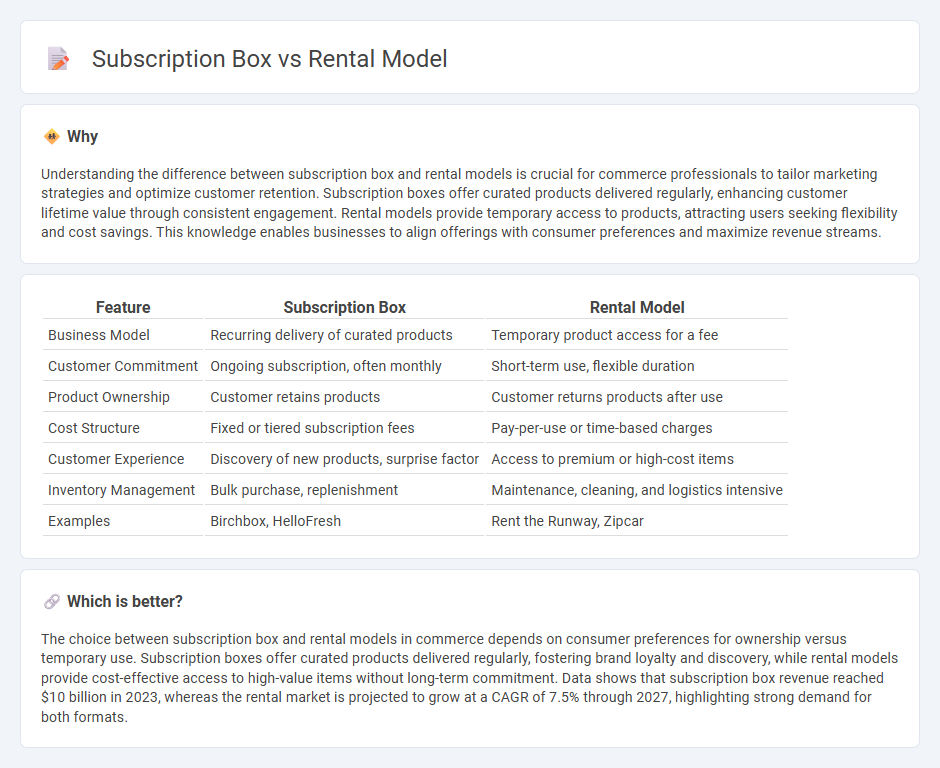
Subscription box services offer curated products delivered regularly, enhancing customer experience through convenience and surprise elements while fostering brand loyalty. Rental models provide flexible access to high-value items without ownership, appealing to cost-conscious consumers seeking variety and sustainability. Explore the distinct advantages and consumer preferences driving these innovative commerce strategies.
Why it is important
Understanding the difference between subscription box and rental models is crucial for commerce professionals to tailor marketing strategies and optimize customer retention. Subscription boxes offer curated products delivered regularly, enhancing customer lifetime value through consistent engagement. Rental models provide temporary access to products, attracting users seeking flexibility and cost savings. This knowledge enables businesses to align offerings with consumer preferences and maximize revenue streams.
Comparison Table
| Feature | Subscription Box | Rental Model |
|---|---|---|
| Business Model | Recurring delivery of curated products | Temporary product access for a fee |
| Customer Commitment | Ongoing subscription, often monthly | Short-term use, flexible duration |
| Product Ownership | Customer retains products | Customer returns products after use |
| Cost Structure | Fixed or tiered subscription fees | Pay-per-use or time-based charges |
| Customer Experience | Discovery of new products, surprise factor | Access to premium or high-cost items |
| Inventory Management | Bulk purchase, replenishment | Maintenance, cleaning, and logistics intensive |
| Examples | Birchbox, HelloFresh | Rent the Runway, Zipcar |
Which is better?
The choice between subscription box and rental models in commerce depends on consumer preferences for ownership versus temporary use. Subscription boxes offer curated products delivered regularly, fostering brand loyalty and discovery, while rental models provide cost-effective access to high-value items without long-term commitment. Data shows that subscription box revenue reached $10 billion in 2023, whereas the rental market is projected to grow at a CAGR of 7.5% through 2027, highlighting strong demand for both formats.
Connection
Subscription box and rental models are connected through their shared emphasis on recurring revenue streams and customer convenience by delivering curated products or services at regular intervals. Both models leverage personalization and flexibility to enhance customer engagement and retention, adapting to consumer preferences through data-driven insights. These strategies optimize inventory management and reduce upfront costs for consumers, fostering sustained business growth in the commerce sector.
Key Terms
Recurring Revenue
Rental models generate recurring revenue by offering customers flexible, time-bound access to products, ensuring consistent cash flow through regular rental fees. Subscription box services secure steady income by delivering curated items periodically, fostering customer loyalty and predictable monthly payouts. Explore how each approach can strategically enhance your business's recurring revenue streams.
Customer Retention
Rental models enhance customer retention by offering flexibility and continuous access to products without ownership commitments, catering to evolving consumer needs. Subscription boxes foster loyalty through curated, personalized experiences that surprise and engage customers on a regular basis. Explore how these models optimize retention strategies in diverse industries.
Product Personalization
The rental model provides personalized experiences by allowing customers to choose specific items tailored to their preferences for temporary use, enhancing flexibility and satisfaction. Subscription boxes curate personalized selections based on individual tastes and purchase history, offering a surprise element and convenience with regular deliveries. Explore how each approach leverages data-driven personalization to optimize customer engagement and retention.
Source and External Links
Rent to Rent: A Guide to Increasing Rental Profitability - helpHousing - Rent to Rent is a leasing model where an intermediary leases a property long-term from the owner and sublets it, often by the room, handling all management and tenant responsibilities for a fixed monthly payment to the owner.
A.CRE Build-to-Rent (BTR) Development Model (Updated May 2025) - Build-to-Rent (BTR) is a real estate model developing residential communities for long-term rental, with all units owned and professionally managed by a single entity, offering amenities and rental flexibility attractive to both renters and investors.
Rental Business Model: A Complete Guide - QoreUps - The rental business model focuses on providing temporary access to goods or services, assessed via desirability, feasibility, and viability blocks including customer needs, operational capabilities, and financial returns.
 dowidth.com
dowidth.com